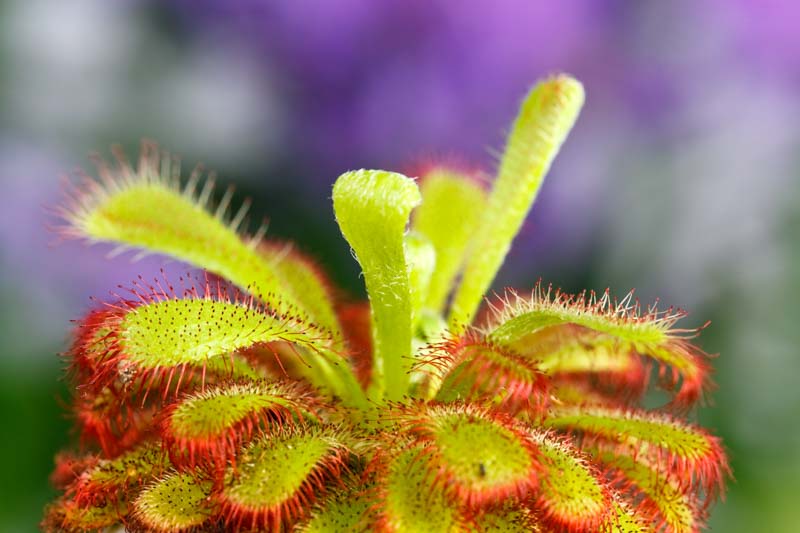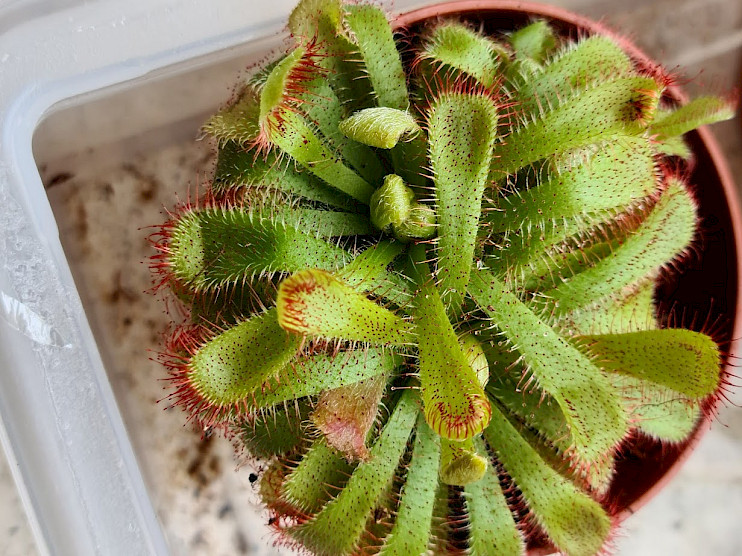

Drosera aliciae
General
Drosera aliciae, also known as Alice Sundew, is an attractive carnivorous plant native to the temperate grasslands of South Africa. Belonging to the genus Drosera, it is prized by collectors for its compact rosetted growth, glistening dew-covered leaves, and ease of cultivation, making it a delightful addition for both beginners and seasoned enthusiasts.
Physical Characteristics
This sundew forms tight rosettes, typically ranging from 4 to 6 cm (about 1.5 to 2.5 inches) in diameter. The spoon-shaped leaves are lined with reddish, glandular hairs (tentacles) that secrete sticky mucilage, reminiscent of morning dew, to trap unsuspecting insects. Over time, with sufficient light, the leaves often develop a striking reddish hue. The flower stalks, rising well above the foliage, produce delicate pink to mauve blooms, each lasting only a couple of days.
Lifestyle
Drosera aliciae is a perennial carnivore, relying on insects as a supplemental source of nutrients. The adhesive mucilage secreted from the leaf tentacles ensnares small prey such as gnats and fruit flies. Once trapped, digestive enzymes break down the soft tissues of the insect, allowing the plant to absorb crucial nitrogen and minerals—an adaptation to its native, nutrient-poor soils.
Habitat and Protection
In the wild, this species thrives in sandy, peaty soils amid the windswept, open grasslands of South Africa's cape region. It prefers high light availability and consistent moisture. Being naturally adapted to a habitat prone to periodic fires and seasonal variation, it is relatively hardy but vulnerable to habitat encroachment and land-use change, thus requiring thoughtful care in cultivation.
Cultivation
Due to its manageable size, ornamental appeal, and tolerant nature, Alice Sundew is popular in cultivation. It flourishes in greenhouses, terrariums, or even sunny windowsills, provided its basic care requirements are met. Propagation is straightforward via seed, leaf cuttings, or division.
Special Features
- Dewy Gleam: Leaves are perpetually adorned with sparkling glands, earning the common name "dew plant."
- Colorful Growth: With high light, the rosette's vibrant pink-red coloration intensifies.
- Insect Control: It can help keep small flying insect populations in check in your home or greenhouse.
Care
Light
This sundew loves bright, indirect sunlight. Direct morning sun and filtered afternoon light are ideal: locate near a south or east-facing window, or provide fluorescent grow lights for 12–16 hours per day. Lack of light leads to green, stretched growth, while abundant light encourages a beautiful reddish coloration.
Temperature
Native to a mild climate, it prefers temperatures between 15–30°C (59–86°F) during the day, with a modest drop at night. Avoid sudden cold drafts or overheating in intense midday sun, particularly behind glass.
Water
Keep the growing medium constantly moist but not waterlogged. Stand the pot in a tray containing 1–2 cm (about 0.5–1 inch) of rainwater, distilled, or deionized water. Never let the soil dry out, and avoid watering from above to prevent disturbing the delicate rosettes.
Soil
Use a mix of 2 parts sphagnum peat moss to 1 part perlite or silica sand—avoiding any fertilizer-enriched or lime-based soils. Good drainage, acidity, and nutrient-poor conditions mimic its natural habitat and are essential for healthy growth.
Nutrition
Do not fertilize with chemical fertilizer; the plant obtains nutrients from captured insects. If kept indoors where prey is sparse, you can offer small insects (such as fruit flies) every couple of weeks with tweezers. Do not overfeed.
Humidity
Moderate to high humidity (50–80%) is preferred, especially for young or newly acclimated plants. However, established individuals tolerate average room humidity if kept moist at the roots.
Dormancy
Unlike some temperate Drosera, Alice Sundew does not require a pronounced winter dormancy. Growth may slow slightly in winter with reduced light and cooler temperatures but will resume with the return of brighter conditions.
Common Problems
Slow or pale growth
Cause: Insufficient light or low humidity.
Solution: Move the plant to a brighter location or provide supplemental lighting. Place a shallow tray of water nearby to help increase humidity.
Burnt or blackened leaf tips
Cause: Mineral-rich (hard) tap water, or waterlogged, anaerobic soil.
Solution: Use only distilled, rain, or deionized water, and ensure the soil is airy and not compacted.
Lack of dew on leaves
Cause: Low humidity, pest infestation, or shock from repotting.
Solution: Mist gently with distilled water, check for aphids or mites, and ensure stable temperature. Plants usually recover dew production after acclimation.
Poor trap response to insects
Cause: Cold temperatures or weak plant health.
Solution: Maintain temperatures within the recommended range and assess for root rot or pests.
